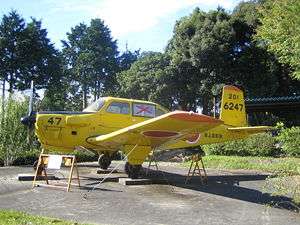Fuji KM-2
| KM-2 | |
|---|---|
 | |
| Role | Primary trainer |
| Manufacturer | Fuji |
| First flight | 16 January 1962 |
| Introduction | 1962 |
| Primary users | Japan Air Self-Defense Force Japan Maritime Self-Defense Force Japan Ground Self-Defense Force |
| Number built | 64 |
| Developed from | Beech T-34 Mentor |
| Variants | Fuji T-3 |
The Fuji KM-2 is a Japanese propeller-driven light aircraft, which was developed by Fuji Heavy Industries from the Beech T-34 Mentor which Fuji built under licence. Various versions have been used as primary trainers by the Japan Self-Defense Forces, with the KM-2B remaining in service with the Japan Air Self-Defense Force.
Design and development
Fuji Heavy Industries was established in July 1952 as a successor to Nakajima, and undertook licensed production of the Beech T-34 trainer aircraft as its first product.[1] This was used by Fuji for the development of the Fuji LM-1 Nikko which was a four-seat liaison aircraft powered by a 225 hp Continental O-470 engine, with introduction of a more powerful 340 hp Lycoming O-480 engine resulting in redesignation as the LM-2, with both the LM-1 and LM-2 being used by the Japan Ground Self-Defense Force.[1]
The KM was a four-seat civil version of the LM-1, fitted with the more powerful Lycoming engine that was later used by the LM-2. After the KM was used by the Japanese government for civil pilot training, the KM-2 was developed as a side-by-side two-seat trainer, first flying on 16 January 1962.[1] Sixty-two were purchased by the Japan Maritime Self-Defense Force as primary trainers, with a further two purchased by the Japan Ground Self-Defense Force as the TL-1.[2]
The KM-2B was a further development of the KM-2 for use as a primary trainer for the Japan Air Self-Defense Force. It combined the structure and engine of the KM-2 with the tandem cockpit of the T-34 Mentor, first flying on 17 January 1978.[2] Fifty were purchased by the JASDF as the Fuji T-3, production continuing until 1992.[2]
Operators
Specifications (KM-2)
Data from Jane's All The World's Aircraft 1966–1967[3]
General characteristics
- Crew: 2
- Length: 7.94 m (26 ft 0 3⁄4 in)
- Wingspan: 10.00 m (32 ft 10 in)
- Height: 2.92 m (9 ft 7 in)
- Wing area: 16.49 m2 (177.6 sq ft)
- Empty weight: 1,134 kg (2,500 lb)
- Max. takeoff weight: 1,750 kg (3,860 lb)
- Powerplant: 1 × Lycoming IGSO-480-A1A6 air-cooled flat-six piston engine, 254 kW (340 hp)
Performance
- Maximum speed: 378 km/h (204 knots, 234 mph) at 4,880 metres (16,010 ft)
- Cruise speed: 304 km/h (158 kmots, 182 mph) at 3,050 m (10,010 ft)
- Stall speed: 100 km/h (54 knots, 62 mph) (flaps down)
- Range: 975 km (526 nmi, 605 mi)
- Service ceiling: 8,170 m (26,800 ft)
- Rate of climb: 7.7 m/s (1,520 ft/min)
See also
- Related development
References
| Wikimedia Commons has media related to Fuji aircraft. |
- Taylor, John W. R. (1966). Jane's All The World's Aircraft 1966–67. London: Sampson Low, Marston & Co. Ltd.